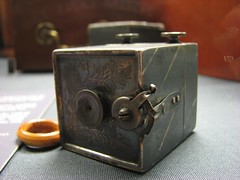Difference between revisions of "The Kombi"
m |
|||
| Line 1: | Line 1: | ||
| − | '''The Kombi''' was the first non-Kodak roll film camera for which [[Kodak]] produced an own type of film | + | '''The Kombi''' was the first non-Kodak roll film camera for which [[Kodak]] produced an own type of film. It was made by Alfred C. Kemper of Chicago, Illinois USA, after the American William V. Esmond received a patent on it in England in 1892. Kemper and Esmond shared the rights on this successful 1890s miniature box camera that could make 25 exposures in 1 1/8×1 1/8" square format on one roll of transparent film. It was an all-brass construction. Different aperture plates could be mounted over its lens opening. It's main advantage was the exchangeable roll film magazine as camera back. The magazine with the exposed film had to be sent to the factory for film development and reloading. The camera was sold by the tens of thousands. |
{{Flickr_image | {{Flickr_image | ||
Revision as of 19:22, 3 September 2007
The Kombi was the first non-Kodak roll film camera for which Kodak produced an own type of film. It was made by Alfred C. Kemper of Chicago, Illinois USA, after the American William V. Esmond received a patent on it in England in 1892. Kemper and Esmond shared the rights on this successful 1890s miniature box camera that could make 25 exposures in 1 1/8×1 1/8" square format on one roll of transparent film. It was an all-brass construction. Different aperture plates could be mounted over its lens opening. It's main advantage was the exchangeable roll film magazine as camera back. The magazine with the exposed film had to be sent to the factory for film development and reloading. The camera was sold by the tens of thousands.

|
"Kombi" meant that the camera's film magazine could be loaded with a developed film and then be used as film viewer (graphoscope). That made the camera being a combination of both, a camera and a viewer.